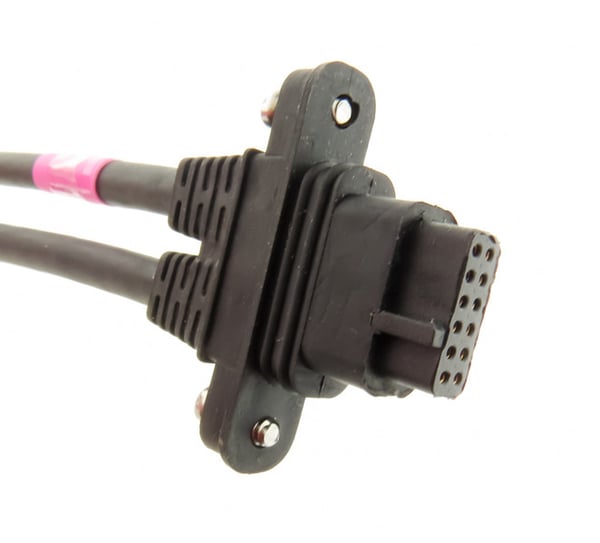When developing an overmold tool for a custom cable assembly, consideration needs to be given to the tactile features of the finished part. There are several areas that constitute these considerations, including the desired finish of the end part as well as the precision of the molding tool itself. The choices you make in physical features may seem insignificant, but the touch, feel, and appearance can have a real impact on the final cable assembly.
Feel & Finish of Overmolded Cable Assemblies
One of the first considerations that a designer will need to address is the feel and the finish of the end part. To enhance the grip of the cable assembly, users request that the finished part have a soft feel or be able to be compressed a small amount. This softness or minimal compression will allow the user to obtain a much better grip on the cable allowing it to be used under adverse conditions such as wet areas like operating rooms or some industrial environments.

Overmolded Cable Assembly Designed with Soft Feel
Designers usually associate the type of grip feel with a soft compound but in reality the softness of the molding compound does not contribute substantially to the feel of the product when the thickness of the molding compounds drops below a certain point. That point fluctuates but usually it is in the range of 0.040”. If the thickness of the mold compound drops below this point even a soft compound will have a hard feel. If a thin overmold wall is needed, the product can be designed with raised ribs placed close together which will provide a cushy feel and use a minimum of molding material.
Molding Compound Shrinkage
Another area of concern should be the shrinkage of the molding compound. Shrinkage characteristics vary depending on the type of molding compound that is to be used, the cable and mold design, and the processing conditions themselves. Given the variety of compounds available, even those within the same family will have varying shrinkage. For instance, within the TPE family of compounds shrinkage will vary significantly depending on the characteristics of the individual compound.
The mold design will have an impact on shrinkage especially if there are varying thicknesses of mold material. For best results the wall thickness throughout the mold should be as uniform as possible as well as radiuses of corners within the mold.
Mold Corner Radius
Sharp corners within a mold should be avoided. Corners should have a radius of 0.020” as a minimum to allow the proper flow of molding materials. The molding tool should be designed in such a manner to have the shortest flow lengths as possible. Flow length is the distance the molding compound needs to travel within the molding tool to properly fill in the entire mold.
Cable Overmolding Process Considerations
The molding process plays a role in the cosmetics of the finished part as well. Molding machines of different types can have an impact on the flow and therefore the cosmetics of the finished part. If a machine varies in the temperature of the compound or mold, flow will be impacted and therefore shrinkage will vary within the mold itself at the hotter or cooler spots.
The mold tool needs to be precisely built to avoid flashing when the overmold process is conducted. Flashing is the escape of compound along the mating surfaces of the sections of the mold tool and at entry points of cables or contacts. The slightest variation in flatness of the mold tool, of the recesses in mating tools, or of the cutoffs at entry point, will cause flash. This flash will either need to be trimmed off leaving cut marks or ridges where the two sections of a mold tool meet within the molding machine. A finished part reflects the capabilities of the molding house in that if there are no visible lines, shrinkage marks, or stress marks, the tooling and molding process were properly built and controlled.
The finished texture of the part is considered when the mold tooling is cut. Most mold materials replicate the surface of the mold tool fairly well. If a glossy surface is needed on the finished part, or if high clarity is needed on the finished part, a polished mold cavity within the mold tool will be needed. If a matte finish is desired of the finished part the mold tool will be built with a rougher cavity surface. If other finished part surfaces are desired, the cavity of the mold may need to be etched, sand blasted, bead blasted, or a variety of other methods can be used to obtain the desired finished part surface.
Summary
The design of the mold tooling, molding process, and the choice of mold compounds will each have an impact on the tactility of the end part. Designers will take all of these parameters into consideration when they are designing a molded part and work closely with the assembly/molding house to produce the end part exactly as they desire.















